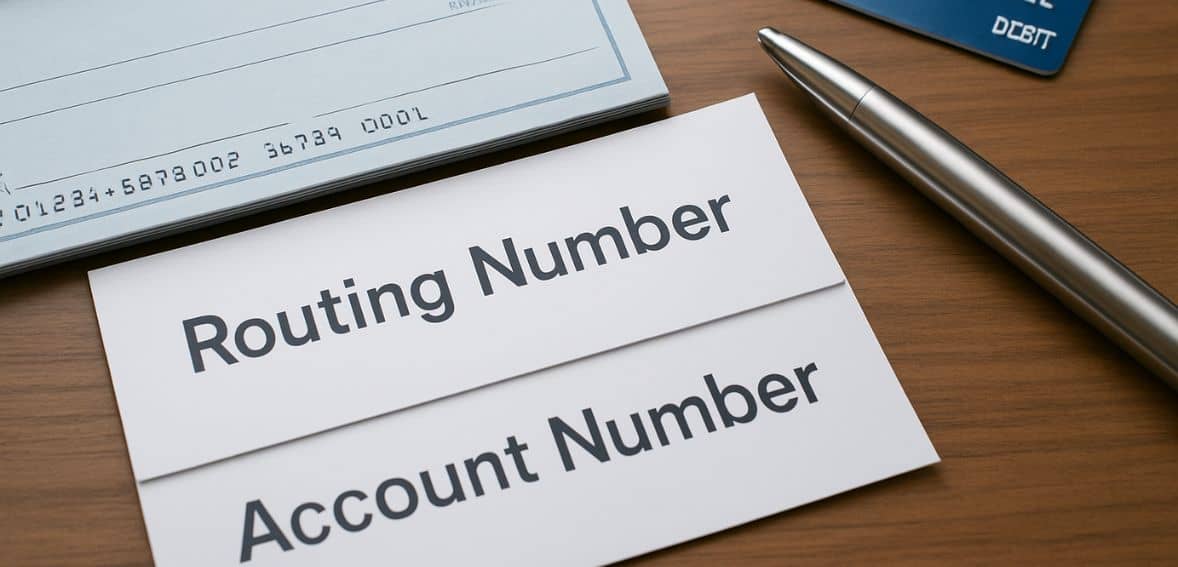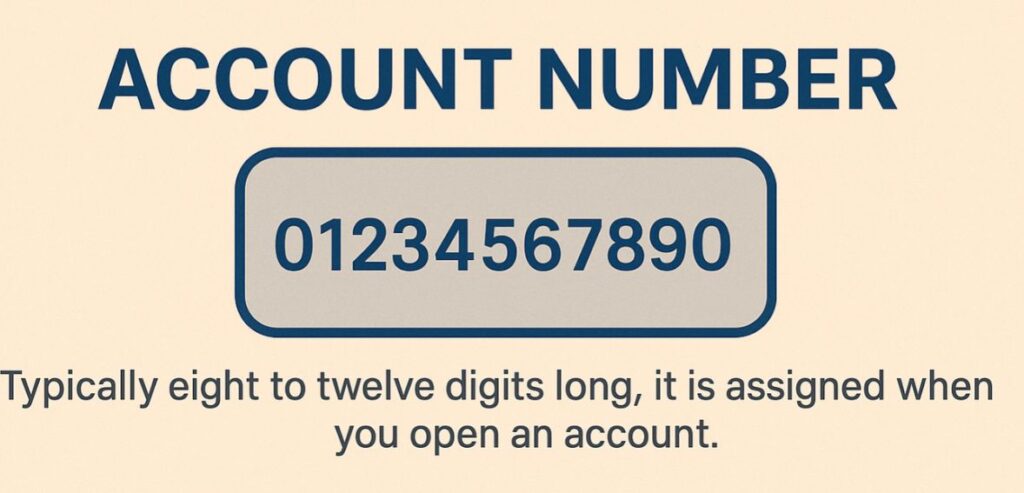
Routing Number vs Account Number: What You Need to Know
Routing Number vs Account Number is a common topic of confusion in banking. These two crucial numbers are frequently used to manage banking transactions, yet they serve very different purposes.They have quite different functions, despite frequently appearing together on paper checks and in online banking. You can handle payments safely and confidently if you know what each one does, how they vary, and when to share them.
What Is a Routing Number

Routing numbers, sometimes referred to as routing transit numbers or ABA (American Bankers Association) routing numbers, are a special nine-digit number that is given to every financial institution in the United States. Consider it the digital equivalent of the bank’s mailing address, as it provides automated systems with precise information about which institution is in charge of processing a transaction.
The ABA established this system in 1910 in an effort to modernize check clearing and lower errors. Routing numbers became essential for future-dated transactions, wire payments, and automated clearing house (ACH) transfers as electronic banking developed. Because the system has built-in validation checks, even a single digit error can result in unsuccessful or misrouted payments, demonstrating its remarkable precision.
Regardless of the type of transaction, the majority of smaller banks only use one routing number. Larger banks, on the other hand, frequently employ several routing codes, such as one for domestic wire transfers, another for ACH, and a third for international wire transfers. For speed and dependability, using the right routing number is essential, particularly for transactions that have a tight deadline.
Each of a routing number’s nine digits serves a specific function. The final digit acts as a checksum to detect errors, the next four digits identify the particular financial institution, and the first four digits identify the Federal Reserve routing symbol. Using the right routing number for the transaction type is essential; big banks frequently have distinct numbers for domestic wire transfers, international wire transfers, and ACH transfers.
What Is an Account Number

In the bank, your account number serves as your unique identification number. When you open an account, your bank assigns you a number that is usually eight to twelve digits long (but occasionally it can be as many as seventeen). Like your PIN or Social Security number, account numbers are private and need to be protected, in contrast to routing numbers, which are visible to the public.
Even though your checking and savings accounts at the same institution have the same routing number, they will each have a unique account number. Whether it’s your checking account at Bank A or your savings account at the same organization, this special identification makes sure deposits or withdrawals go to the right place.
When You’ll Use These Numbers
These figures appear in numerous commonplace banking situations. First, both numbers are nearly always needed when setting up direct deposit for government benefits, tax refunds, or paychecks. When setting up automatic rent, loan, or utility bill payments, businesses usually request them.
Entering correct routing and account numbers is also necessary for online peer-to-peer payments like those made via Venmo or Zelle. You’ll need extra information for wire transfers, both domestic and foreign, such as IBANs or SWIFT/BIC codes. To guarantee that money moves through the bank and into your personal account, the routing and account numbers are still crucial.
Where to Locate Them
It’s simple to find these numbers. The routing number is the first nine digits printed in the lower corner of personal checks, followed by your account number. Both numbers are usually accessible under account details on mobile and online banking platforms. For your convenience, they are also listed on monthly statements, whether they are digital or printed. Finally, if you’re unclear which routing number is appropriate for a particular transaction type, bank customer service is another trustworthy resource.
Security and Privacy Considerations

It is essential understand how sensitive these figures are. Routing numbers are not private; they are used to identify the bank, not you, and are printed on all checks. On the other hand, account numbers are confidential and should only be disclosed securely; they should never be sent via unencrypted email or the open internet. Unauthorized use can have dire repercussions.
To protect your account, possibly set up fraud alerts, or even close the account, get in touch with your bank as soon as you suspect fraud. Some services offer Universal Payment Identification Codes (UPICs), which act as stand-ins for real account numbers during ACH transactions, to lessen your exposure and help with managing ACH disputes.
Routing Number vs Account Number: Key Differences Explained
Routing and account numbers are the foundation of the whole financial transaction ecosystem, and they do more than just transfer money. When used in tandem, they guarantee that funds are transferred to the appropriate organization and credited to the appropriate person or business account. Customers who are aware of their role are better able to control their financial planning and security, avoid transaction errors, and manage their money more skillfully.
The Role of Routing Numbers in Financial Transactions
A routing number guarantees that payments are sent to the appropriate financial institution, much like a bank’s address. Routing numbers have been a crucial component of the banking industry since their introduction in 1910, particularly in electronic transactions such as wire transfers and ACH (Automated Clearing House) transfers. In certain situations, they are also necessary for processing checks and enabling bill payments and direct deposits.
The routing number points the transaction to the appropriate bank or financial organization when a payment is made, whether it’s for a bill, money transfers between banks, or a paycheck. For example, the routing number guarantees that funds move to and from the bank when establishing direct deposit for payroll or direct withdrawal for utilities.
With the global expansion of electronic payments, various kinds of routing numbers have appeared. There are wire transfer routing numbers, which help with faster transactions, particularly for international wire transfers, and ACH routing numbers, which are used for domestic transactions within the United States. International payments may even require a SWIFT code (Society for Worldwide Interbank Financial Telecommunication), which serves a similar purpose to routing numbers but is applicable to banks and nations all over the world.
The Importance of Account Numbers in Personal Banking
The account number guarantees that the money reaches the right person or business account within the financial institution, while the routing number points the transaction in the right direction. Depending on the financial institution’s system, the account number is usually eight to seventeen digits long and is specific to each account holder.
The account number is connected to the holder’s deposit activity in checking or savings accounts, allowing for accurate recording of deposits, withdrawals, and transfers. Setting up payments or receiving money requires sharing this account number with a reliable individual or service provider. It’s crucial to protect your account number, though, because dishonest people might use it to gain illegal access to your money.
Additionally, it can occasionally cause confusion to have several accounts at the same institution. Knowing which account number is used for each transaction is crucial to preventing mistakes, particularly when working with savings accounts or recurring payments. Accurate and efficient financial management depends on this distinct identification.
A Foundation for Long-Term Financial Planning

The function of account numbers in long-term financial planning is one frequently disregarded feature of personal banking. Your account number acts as the link that connects all of your banking activities to a particular financial identity, whether you’re managing several sources of income, creating tax returns, or creating a monthly spending plan.
When handling audits, spending analysis, or statement reconciliation, this traceability becomes even more crucial. For example, you can monitor the growth of your savings or identify irregularities early on—before they become more serious financial issues—by having access to accurate historical transaction data, which is tracked and filed under your unique account number.
Seamless Integration with Financial Apps
Account numbers are now the basis for integrating third-party applications in the era of digital banking. Almost all financial apps, from tax software and automated investing platforms to budgeting tools like Mint or YNAB, depend on your account number to safely sync and analyze your financial data.
Although these integrations give consumers previously unheard-of financial control, they also impose additional accountability. Your whole financial profile could be put at risk if your account number ends up in the wrong hands and is used improperly on connected platforms. Unauthorized access to payment services, investment tools, or budgeting apps can lead to fraud that impacts numerous aspects of your financial life.
Almost all financial apps, from tax software and automated investing platforms to budgeting tools like Mint or YNAB, depend on your account number to safely sync and analyze your financial data in line with evolving banking technology
Mobile Banking and Remote Verification

Account numbers are also essential for remote account verification and mobile check deposits. Users can now deposit checks by just snapping a picture of them thanks to mobile banking apps, and the account number that is encoded on the check’s bottom guarantees that the deposit is processed properly. Likewise, the process of verifying ownership of mobile wallets or electronic fund transfers frequently entails a sequence of micro-deposits sent to your account number. Your account number is crucial to modern banking experiences, and these modern conveniences rely on its complete security and accuracy.
Managing Multiple or Joint Accounts Effectively
Knowing the meaning of each account number becomes even more important for those in charge of joint accounts or custodial accounts for minors. Keeping track of which account is linked to which financial responsibility helps prevent expensive confusion in situations where multiple users may have authorized access to the same account. A parent might have three accounts: one for everyday transactions, one for household expenses, and one for a child’s college fund. If these are overlooked when setting up a payment or transferring investments, money may be misallocated or there may even be tax issues.
Correct Usage in Debt and Credit Management
The proper use of account numbers guarantees that payments are applied to the correct balance in situations involving debt repayment or credit score maintenance. Each loan or credit line you pay off with the same bank, such as a credit card, personal loan, and auto loan, will have its own account number. When a payment is made, entering the wrong account number may cause delays, missed payments, or the payment to be applied to the incorrect account completely. Interest fees, interruptions in service, or even bad marks on your credit report could result from this.
Proactive Security Measures for Account Numbers
You should keep a close eye on account activity and keep your account number safe to further safeguard your money. Do not write it down in places that are easily accessible, and do not send it via unencrypted email or messaging services. Use portals that have been approved by the bank when entering account information online, and always make sure that a request for this information is legitimate, particularly if it seems to be from a service provider. Because compromised account information is often the first step in identity theft or unauthorized transactions, prevention is far less expensive than recovery in the digital age.
Conclusion: The Account Number as Your Financial Key
Therefore , the account number is what guarantees that your transaction lands in your particular financial backyard, even though routing numbers may direct it to the right financial institution. The account number is essential for personal banking, from handling recurring payments to integrating fintech apps and ensuring security.
It is not only wise to handle it with the same degree of attention as a government ID or Social Security number, but it is also necessary to preserve financial stability and prevent the expensive fallout from fraud or poor management. Your account number continues to be your main key to accessing, managing, and protecting your money as personal finance becomes more digital and linked.